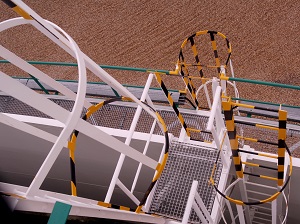Fixed ladders, whether located indoors or outdoors, are commonly used to provide access for inspection, maintenance, equipment servicing, and elevated work areas. These ladders are permanently attached to a structure and are often viewed as safer or more stable than portable ladders. However, fixed ladders still present serious fall, slip, and contact hazards if they are not properly designed, maintained, inspected, and used correctly.

Because fixed ladders are often used repeatedly and may be exposed to weather, corrosion, or heavy use, employers and workers must remain vigilant about ladder condition and safe climbing practices.
Inspection and Maintenance of Fixed Ladders
All fixed ladders must be visually inspected before use to identify any defects or unsafe conditions. Inspections should focus on both the ladder structure and the surrounding area.
Any fixed ladder found to have structural damage, loose components, or other defects must be immediately tagged “Dangerous: Do Not Use” and removed from service until it is repaired or replaced.
OSHA Standard 1910.23(b)(9) states that the employer must ensure Ladders are inspected before initial use in each work shift, and more frequently as necessary, to identify any visible defects that could cause employee injury.
During inspections, check for:
- Loose, bent, cracked, or missing rungs
- Cracks, corrosion, or damage to side rails
- Sharp edges, protruding bolts, screws, or nails that could cause puncture or laceration injuries
- Slippery substances such as oil, grease, mud, ice, or moisture on rungs or steps
Fixed ladder surfaces should always be kept clean and dry to prevent slips.
Fixed wooden ladders must not be coated with paint or other materials that could obscure cracks, splits, or other structural defects.
OSHA Standard 1910.23(b)(6) states that the employer must ensure Metal ladders are made with corrosion-resistant material or protected against corrosion.
Fall Protection Requirements for Fixed Ladders
Fall protection may need to be provided for workers that use fixed ladders. OSHA Regulations were updated in January 2017.
- Fixed ladders that exceed 24 feet must be equipped with a personal fall arrest system, ladder safety system, cage or well.
- IMPORTANT: All fixed ladders installed on or after Nov. 19, 2018 must be equipped with a personal fall arrest system or a ladder safety system.
- OSHA Standard 1910.28(b)(9) provides clarification on required fall protection for fixed ladders.
Employers must ensure workers are trained on how to properly use any fall protection system installed on a fixed ladder.

Safe Climbing Practices for Fixed Ladders
Even when a fixed ladder is properly designed and equipped with fall protection, safe climbing behavior is critical.
Workers should always:
- Maintain three points of contact while climbing (two hands and one foot, or two feet and one hand).
- Face the ladder at all times when climbing up or down.
- Keep at least one hand firmly grasping the ladder while climbing.
- Climb slowly and deliberately.
OSHA Standard 1910.23(b)(11) states that the employer must ensure Each employee faces the ladder when climbing up or down it; and (12) each employee uses at least one hand to grasp the ladder when climbing up and down it.

Preventing Loss of Balance and Falls
Losing balance is a leading cause of fixed ladder incidents. To reduce this risk:
- Do not overreach to either side of the ladder.
- Do not carry loads that could cause imbalance while climbing.
- Use tool belts, hoists, or hand lines to move tools or materials.
- Never climb with slippery footwear or contaminated gloves.
Always ensure there is nothing slippery on ladder rungs, steps, or footwear before climbing.
Do not use a fixed ladder that has a pitch greater than 90 degrees from the horizontal, as this increases fall risk and reduces climbing stability.
Ladder Access and Surrounding Area Safety
The areas at the top and bottom of a fixed ladder must be kept clear at all times. Obstructions can create trip hazards, block emergency egress, or interfere with safe climbing and transitions on or off the ladder.
Before climbing:
- Confirm the landing area is stable and free of debris.
- Ensure guardrails, gates, or access protections are in place where required.
- Verify that no equipment, materials, or doors interfere with ladder access.
Final Ladder Safety Reminders
While fixed ladders are a permanent part of many facilities, they still require regular inspection, proper fall protection, and safe climbing practices to prevent serious injuries. Treat every fixed ladder climb as a potential fall hazard and take the time to verify that conditions are safe before ascending or descending.
Regular training, inspections, and attention to ladder condition are essential parts of an effective fixed ladder safety program.

.jpeg)